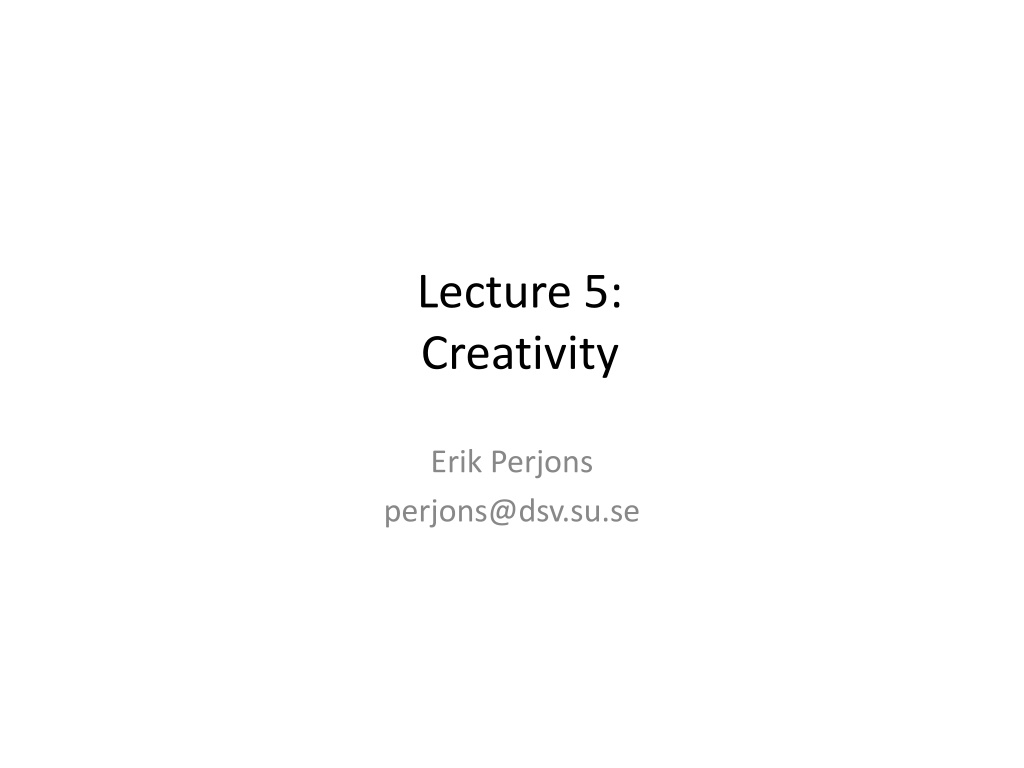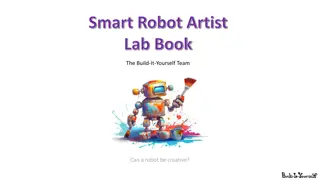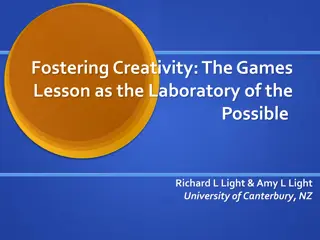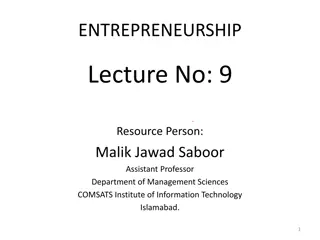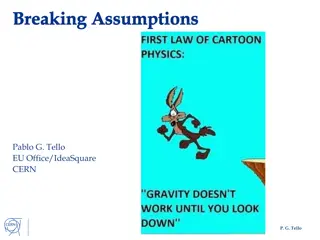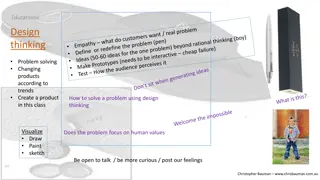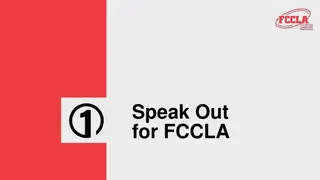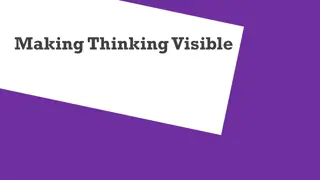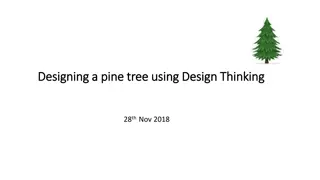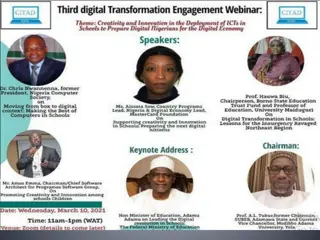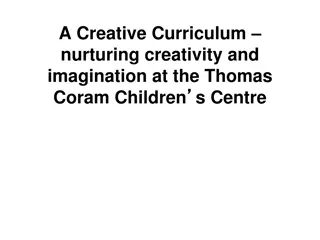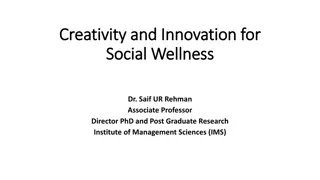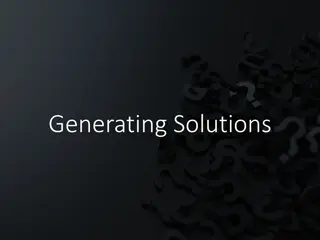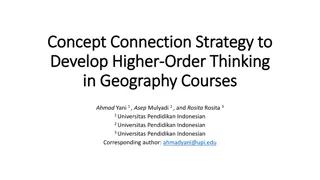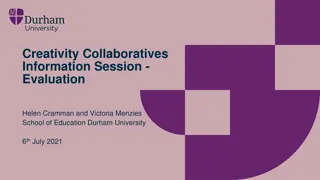Exploring Creativity and Design Thinking Strategies
Understand the concepts of divergent and convergent thinking in creativity, the importance of empathetic thinking in design, and the role of lateral thinking in generating innovative ideas. Guidelines emphasize the need to allow sufficient time for divergent thinking to foster creative outcomes before moving to convergent thinking. Real-world examples demonstrate how companies like Colgate-Palmolive apply empathetic design to enhance products based on observing user behavior. Unlock your creative potential by blending these strategic approaches in problem-solving.
Uploaded on Oct 07, 2024 | 0 Views
Download Presentation

Please find below an Image/Link to download the presentation.
The content on the website is provided AS IS for your information and personal use only. It may not be sold, licensed, or shared on other websites without obtaining consent from the author. Download presentation by click this link. If you encounter any issues during the download, it is possible that the publisher has removed the file from their server.
E N D
Presentation Transcript
Lecture 5: Creativity Erik Perjons perjons@dsv.su.se
Divergent thinking Divergent thinking is a thinking that involves the generation of multiple, alternative ideas or solutions to address a problem. Divergent thinking - is highly imaginative and innovative While divergent thinking is essential for successful design and development, it needs to be complemented with convergent thinking
Convergent thinking Convergent thinking is a thinking that evaluates alternative ideas and solutions that have been generated and select among them Convergent thinking is a more rational and analytical than convergent thinking
Guidelines It is important to spend enough time in the divergent thinking phase in order to generate many alternative before entering the convergent thinking phase Sometimes, the divergent thinking phase can be perceived as too time-consuming and unproductive, in the sense that it produces results of uncertain value. Therefore, there is always a risk that the participants in this process will strive towards early consensus, which inhibits the generation of ideas
Empathetic thinking Empathetic thinking (or empathetic design) - is the approach in which a designer tries to see the world through the eyes of others, understand the world through their experiences, and feel the world through their emotions (Brown 2009) Undertaking empathetic thinking is like working as an anthropologist, who explores a foreign culture to understand, in depth, the values and behaviour of that culture. By spending some time and observe users in their natural settings, new ideas can be created.
Empathetic thinking Colgate-Palmolive researchers videotaped people in their homes to see how they used, combined, and made comments about the company s products, so that the company could enhance them and design new ones (Leonard and Swap 1999).
Lateral thinking Lateral thinking (Bono 2010) - suggests a non-traditional way of reasoning. Instead of focusing on logical, step-by-step arguments, de Bono suggests a spectrum of techniques for generating fresh ideas One such technique is random generation, in which the thinker chooses a random object and relates it to the area of concern, thereby generating new ideas to be used Another group of techniques is provocative generation, such as wishful thinking, exaggeration, and techniques in which anything can be questioned, especially generally accepted truths
Lateral thinking Six thinking hats - is another approach by Bono (Bono 1999), which assists a group or a person to think in six different directions. By using the technique of six thinking hats, this generation of ideas can be carried out in a structured and conscious way. Otherwise, a group or person that is trying to generate ideas moves in a non-structured way between specifying the goal of a task, carrying out creative thinking, engaging in critical thinking, etc.
Brainstorming In brainstorming participants attempt to produce as many ideas as possible, encourage new and unusual ideas, discourage criticism, and integrate and improve ideas that have been proposed. Brainstorming is a generic instrument for idea generation that has been applied in many areas. First, a group could identify possible activities by trying to suggest and document as many as possible without any criticism. The next step could be to remove duplicated activities or organize smaller activities into larger ones. Finally, the group could prioritize among the suggested activities in order to select the most useful ones.
Brainstorming Research has shown that brainstorming can be made more effective by preparing and training group members before a brainstorming session, and making use of a trained moderator during the session (Isaksen 1998).
Brainstorming It has often been assumed that groups generate more and more novel ideas than individuals working by themselves. However, research does not support this assumption, and a combination of individual and group work can be preferable (Isaksen 1998, Diehl and Stroebe 1987). Before a brainstorming session begins, participants should be given the opportunity to generate ideas on their own and suggest these ideas to the group. Moreover, Simonton (2003) reports, interestingly, that people are not very good at recognising their best ideas
6-3-5 brainwriting A method, similar to brainstorming, but that emphasizes creativity among individuals is the method 6-3-5 brainwriting (Heslin 2009). The method involves 6 participants who each writes down 3 ideas in 5 minutes. Each participant s ideas are then passed on to another participant who uses the ideas as inspiration to create further ideas. The method is carried out in 6 rounds during 30 minutes. In this way the participants inspired each other without loosing individual creativity (because of group thinking)
Participative modelling In the area of IT and information systems, a commonly used instrument for the generation of ideas is participative modelling (Stirna et al. 2007). To some extent, participative modelling resembles brainstorming, but uses specific techniques for expressing ideas, such as goal, process, and conceptual models. It also makes use of certain tools for the visualisation and development of cooperative models, e.g. whiteboards, plastic sheets, and post-its.
Leonard&Swap: When sparks fly: Harnessing the power of group creativity 1(3) The authors present approaches for generating and elaborate many creative options. Thereby, several options with high quality can be created If premature concensus is createed too early, only few alternative is generated. Therefore, convergent and divergent thinking must be in balance [Leonard-Barton, Dorothy, and Walter C. Swap. When sparks fly: Harnessing the power of group creativity. Harvard Business School Press, 2005.]
Leonard&Swap: When sparks fly: Harnessing the power of group creativity 2(3) Factors that drive towards too early convergence: time pressure directive leadship (compare an open and closed leadership) isolation from outside opinions group cohesiveness/group thinking group norms (such as, do not interfer with others peoples job , try to keep everybody happy , do not contradict the boss ) [Leonard-Barton, Dorothy, and Walter C. Swap. When sparks fly: Harnessing the power of group creativity. Harvard Business School Press, 2005.]
Leonard&Swap: When sparks fly: Harnessing the power of group creativity 3(3) The book emphasises the importance to support dissenters, that is, these who disagrees in matters of opinions and beliefs that the rest of the group have Therefore, introducing a devils advocate role can be very important [Leonard-Barton, Dorothy, and Walter C. Swap. When sparks fly: Harnessing the power of group creativity. Harvard Business School Press, 2005.]
